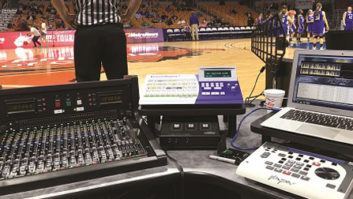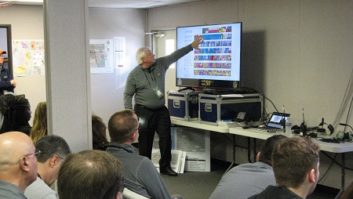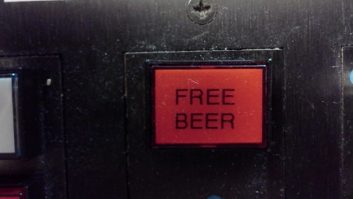For most radio and video journalists, a shotgun and a lavalier microphone are pretty much the salt and pepper of sound acquisition in the field. But recently parabolic microphones have started to appear in productions outside of their typical use in sporting events and nature documentaries.

Travis Gilmour of Video Dads frames a shot while the Klover KM-16 captures the audio.
Video Dads recently took the Klover MiK 09, from Klover Products, for a spin in a review used as an on-camera parabolic microphone. Also known as the Sound Shark, it’s really pretty small (compared to the traditional options), but it still offers some of the benefits of larger, professional parabolic sound capture to the videography or radio journalism world. It’s a unique alternative to shotgun microphones, and it’ll be interesting to see if it’s adopted by event and documentary producers. You can find the review at Gear Dads.
But is there also a place for the more traditional, mid-size Klover MiK 16 (also listed as KM-16) in broadcast radio and video production? We were curious, so we took this bigger brother 16-inch parabolic microphone to a once-in-a-lifetime event: the recent total solar eclipse in Corvallis, Ore. Klover microphones are a staple in live sporting event productions such as the NFL and Olympic coverage, but we wanted to see how one would fit into a typical news or documentary workflow.
INTERESTING OPTION
The first thing you should know about parabolic microphones is that what you’re buying is really not the microphone. The real product here is the physical dish that is designed to focus sound into the center of a parabolic dish. With the Klover setups, you can use any lavaliere microphone to capture the sound itself. The company provides several mounting options for the dish along with preamplifiers and lavaliere microphones from Sennheiser (MKE2-P), Countryman (B3) or their own KMEQ.

This view of the smaller MiK 09 provides a detailed look at the lavalier microphone module.
But with the basic package, it means if you already have a favorite omnidirectional lavalier mic, you can use it. It’s fairly simple to setup and remove when you need the mic for more traditional interview recording. This feature alone makes a parabolic microphone an interesting option for budget radio and video producers — if you can only really afford one trusted lav mic, you can use it for both interviews as well as long distant audio capture.
The Klover MiK 16, starting at $1,249 is not as large as Klover’s flagship parabolic microphone, the MiK 26 (KM-26), which can collect audio from 500 feet away. That’s the setup you’ll see on the sidelines of major sporting events. But, at 16 inches across, the MiK 16 definitely still draws attention to itself. At the eclipse event, multiple people came up to us, asking what in the world we were doing with this gizmo.
So while perhaps a parabolic microphone doesn’t often turn heads at a sporting event, in a typical environment, you can expect some interest from passersby. That’s an important consideration for those who want to capture location audio without drawing attention to themselves, especially solo multimedia journalists.

A view of parabolic microphone design on the MiK 09.
On the plus side, the Klover MiK 16 can pick up sounds from up to 300 feet away. For productions where you can’t get that close to subjects, that can be an unprecedented lifesaver. We used a super-telephoto lens (Canon 70-200 mm with a 1.4x extender), so we shot from a distance where most subjects could not even see us. This enabled us to capture candid and natural crowd reactions, a far cry from placing a shotgun microphone inches from a subject’s mouth.
With a tool that can record conversations from hundreds of feet away, there are of course some privacy concerns. But radio and video professionals will know when it’s inappropriate to use high-powered tools — such as super-long lenses — when other options are available. Public events where you can’t or don’t want to get any closer to subjects, however, are a perfect case for the parabolic mic.
PUT THEM TO WORK
Imagine an assignment where you’re recording local sporting events, and you don’t have access to the fully-loaded trucks and associated crews, that major outlets bring to big events. Parabolics would be ideal for large remotes, for instance at a city park or local arena. Your station may be spending a lot of money and has heavily promoted an event so why fall-down on the effort with unprofessional sound?
A serious news department could make use of an MiK 16 covering news events or demonstrations, where you can capture the crowd noise and reactions without overly influencing the scene or getting too close to dangerous situations such as fires. Or if you’re tasked with covering townhall meetings where audience members are asking questions from their seats, without microphones. There are many situations where being able to record from a distance can be essential to telling a good audio story or avoiding personal injury or equipment being damaged.

The Klover MiK 16 in action during the solar eclipse event at Oregon State University in Corvallis, Ore.
In our case, we found the MiK 16 to be very easy to use, surprisingly lightweight, and overall it did a good job of capturing dialog from a distance. Now, at an eclipse-watching event where thousands of people are talking at a normal conversational level, there’s only so much magic you can expect from the parabolic, or any microphone for that matter. But when compared to a handheld or on-camera shotgun, we were able to isolate dialog that would otherwise have required a wireless lavaliere attached to a person to capture.
As with any microphone, the raw recording can always be improved with some common EQ techniques and post production noise removal tools. In our experience, the capture from a parabolic microphone does a good job of diminishing off-axis sounds, while highlighting the area that the microphone is pointed toward. It should be noted that parabolic mics are known to be a little “tinny,” which means they’re prone to gathering human voices and natural sounds that have a higher frequency than more bassy sounds. What all that means is when you want to EQ your parabolic recording, you can better isolate the human voice distinctly from a host of common ambient sounds like music, wind or traffic.
Is there a place for a small- or medium-size parabolic microphone in your audio or video production kit? We think it’s a useful tool that many small, but professional, crews or stations should consider adding to their arsenal. While wireless lavalieres are extremely handy, they can experience drop outs, and sometimes you simply can’t attach a lav to the person or object you want to capture. Having an alternative method of recording distant sounds can be the difference between an average story and a sound rich, immersive experience.
Travis Gilmour is co-owner of Video Dads, an Emmy award winning production company specializing in video storytelling for documentary, corporate, and public media clients. Video Dads also run the site Gear Dads, which provide video and audio gear reviews for professional media producers.










